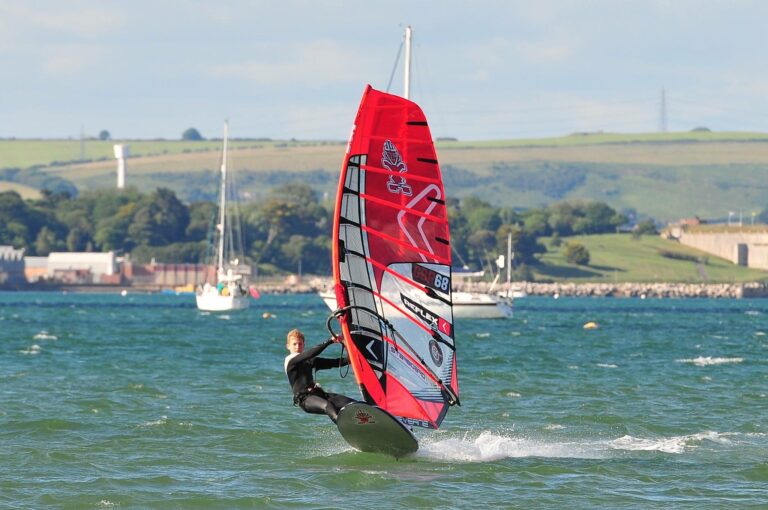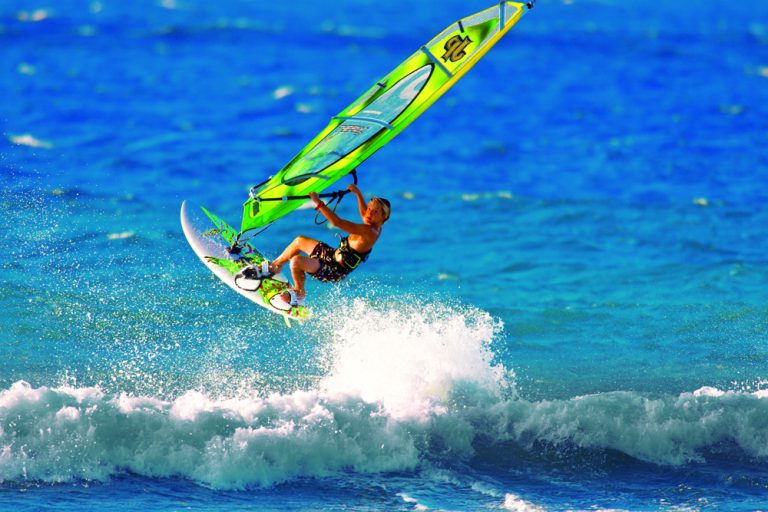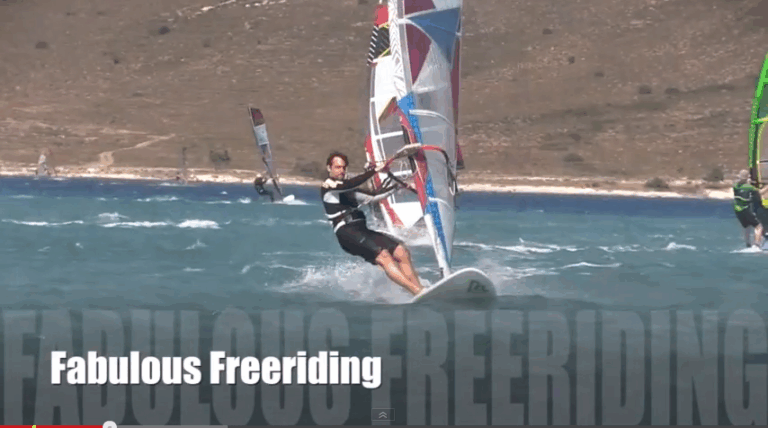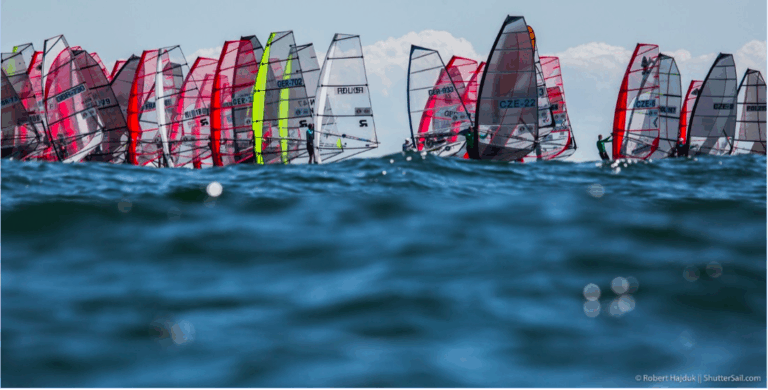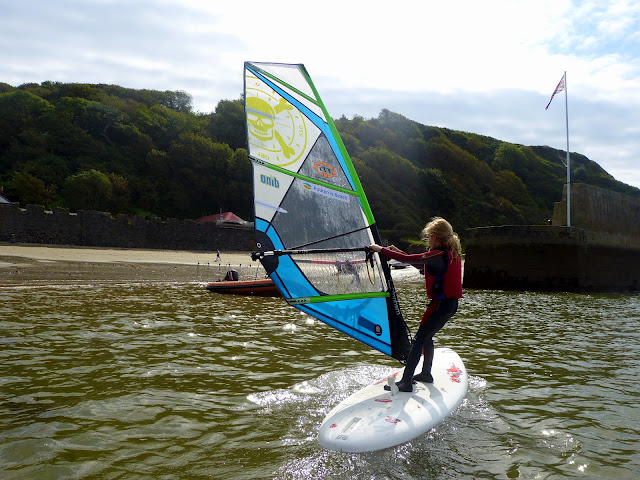Windsurfing is a sport intrinsically linked to mother nature. Windsurfers are not only affected by the weather, but whole heartedly rely upon suitable conditions being provided by the wind gods.
Four British windsurfers, Boards editor Amy Carter and BWA competitors George Shillito, James Cox and Steve Thorp guide you through their beloved sport and how it is affected by the weather.
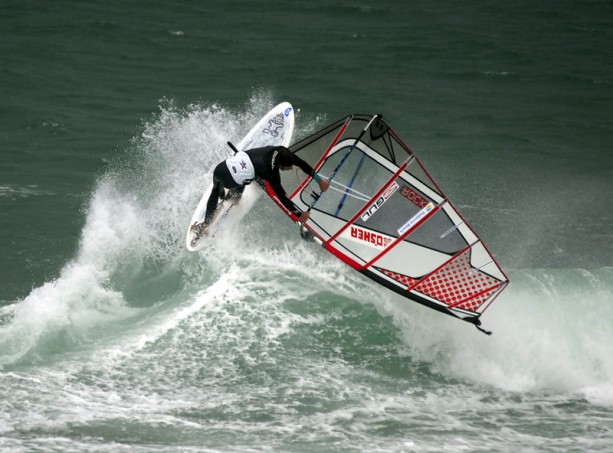
From those taking their first steps on a board through to windsurfing addicts who follow the forecasts daily, we are all eager to find the right conditions and enjoy them to the fullest. Luckily for us the UK provides a brilliant range of windsurfing weather and locations for everyone, but first things first, what is windsurfing?
A windsurfer basically consists of a board, mast, boom and sail. The principle of windsurfing is simple; you stand on the board, with your feet roughly shoulder width apart, and hold the sail up with your hands. The aim is to control the board and execute all the different manoeuvres with a variety of techniques. When you learn to windsurf it will be in a safe, calm environment where you can get to grips with the theory and techniques of the sport. After mastering these you can move onto sailing in more challenging conditions and continually improve your windsurfing ability.
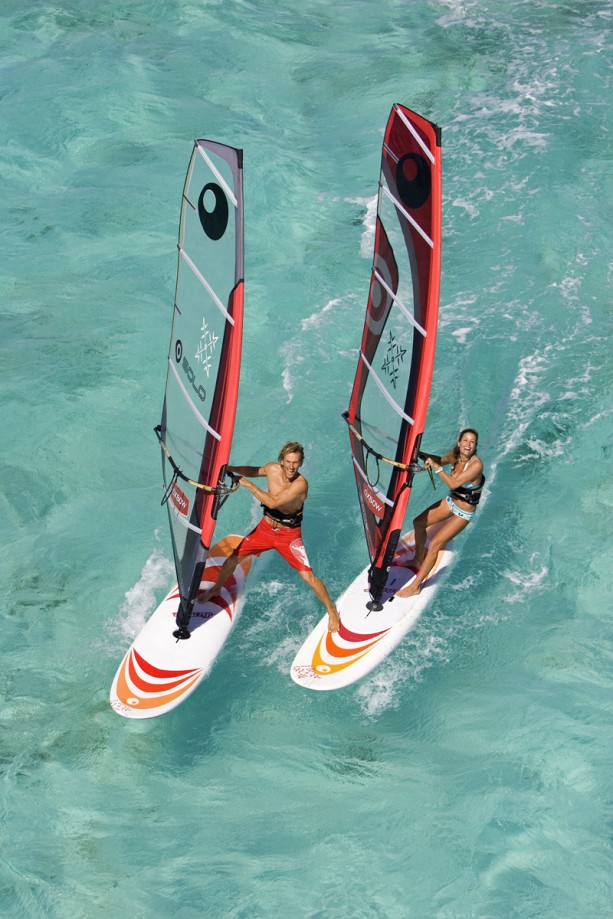
George Shillito, a regular on the BWA (British Wavesailing Association) Tour and former manager of a successful watersports centre, knows all about introducing new people to the sport. George shares his knowledge on getting started in windsurfing, as well as how the weather will affect your first, and all future, sessions on the water.
“For windsurfers, checking a forecast is the blood line that links the first-time novices to the international-travelling, wind-battered professionals. For each and every windsurfer checking the forecast kick-starts a chain reaction of religious routines, preparations and difficult deliberation as to what kit to take, where to take it and why take it there.
Just a few days ago I found myself explaining to a group of keen beginners that their ideal forecast which they should be searching high and low for is a steady force three (on the Beaufort scale) and a Northerly wind making the water nice and flat down here at Polkerris Beach on the South coast of Cornwall. As I found myself uttering these words I was quickly confronted with the question “what’s the windiest you’ve ever been out in?” to which I had to answer “a good force nine to ten!!”
As you can imagine this opened the flood gates to a barrage of questions which got me thinking; what is it that windsurfers look for that make an identical forecast spell disaster for some, but offer perfect conditions for others?
For your first steps on a windsurf board, flat water with a constant light wind (Force 2-3) are more or less ideal to enhance your learning experience, as at this stage you are what is referred to as unconsciously incompetent. You know don’t know what you’re doing as you have never done it before, but then again you have nothing to compare yourself to and your brain is working over-time to ensure you stay upright and resemble something similar to what the instructor is saying nearby. In short, there is much too much to be thinking about to worry whether a small gust maybe just about to collide with your sail as everything you are doing requires thought. For this stage the safer the water the better, so learning at any RYA training centre will insure certain, high quality standards are met.
Once you’ve been bitten by the windsurfing bug you’ll quickly succumb to the excitement and intrigue of learning more and it will soon have you back out on the water. As your experience grows so to do your limits and the gentle winds no longer produce the new arousal levels you are now accustomed. This is due to the fact that as you do more, more of what you are doing becomes subconscious and you do things without thought. Whereas previously you worried about where your hands and feet were, now it comes naturally to you, so your brain has more space to start thinking about new quarrels that it has not encountered before, such as water state and wind inequalities.
As time goes by what once was you perfect forecast is now just seen as a light bit of fun on the water with friends or used to learn new skills for windier days when things happen much faster.
Once you reach planing level (when you overtake your bow wave i.e. go pretty fast!) you will naturally find yourself well on your way to becoming a fully-fledged windsurfer and will have no doubt chosen a discipline you want to focus on.
Windsurfing, like any other sport, has a few main disciplines one can focus their attention on and for each the dream forecast is always slightly different. Most windsurfers don’t necessarily chose which discipline they want to take part in, rather the local beach, lake or area of water set the parameters for what is possible. So below is a list of the main disciplines and for each one I have explained, in short what each require in terms of forecast and kit.
Freeride / Bump and jump:
This is the main type of discipline recreational windsurfers take part in. Ideally they look for about eighteen to thirty knots and use non-specific, go anywhere, do anything boards allowing them to make the most of any wind-blown chop for jumping or sheltered flat water areas for carving manoeuvres.
Wave:
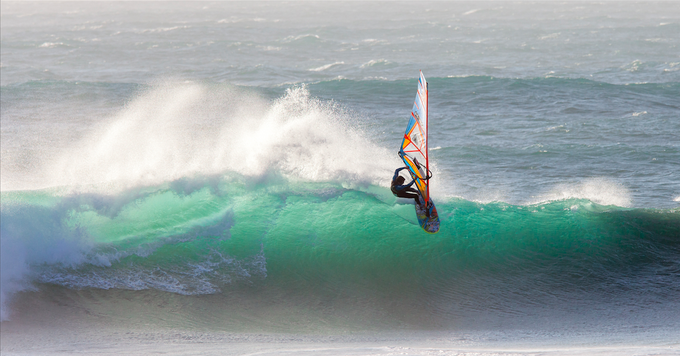
The more extreme end of the windsurfing spectrum. Wave is when windsurfers use waves as stunt ramps for high jumps and tricks such as forward or backward loops. They then surf the wave on the way back in combining bottom and top turns. They have to be on the brink of planning as the boards they use are much smaller (70 – 95 litres) to allow for control on the wave and in the air, ideally twenty-three knots (plus) with wave size anywhere from waist to four metres high or bigger!
Freestyle:
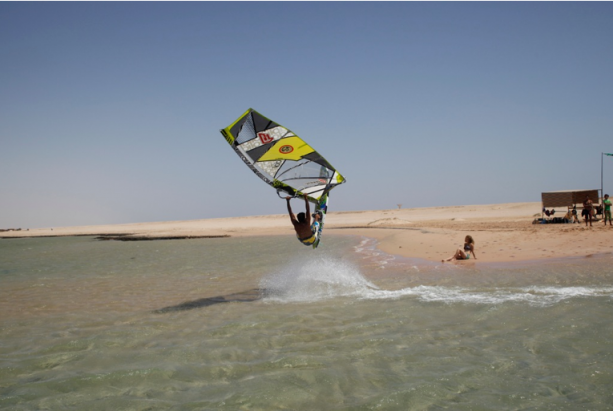
The skateboarding of the windsurfing world. It relies on doing explosive, sliding and spinning manoeuvres on completely flat water, the flatter the water the better. Again this relies on the windsurfer planning but it uses slightly bigger boards (90 – 105 litres) than wave so they can get out in similar winds to freeride, about eighteen knots plus. Freestyle is normally best when a stretch of water, across the wind is sheltered by a low lying wall, sand bar or spit of land for constant wind but has no fetch (area for chop to form on the water).
Race:
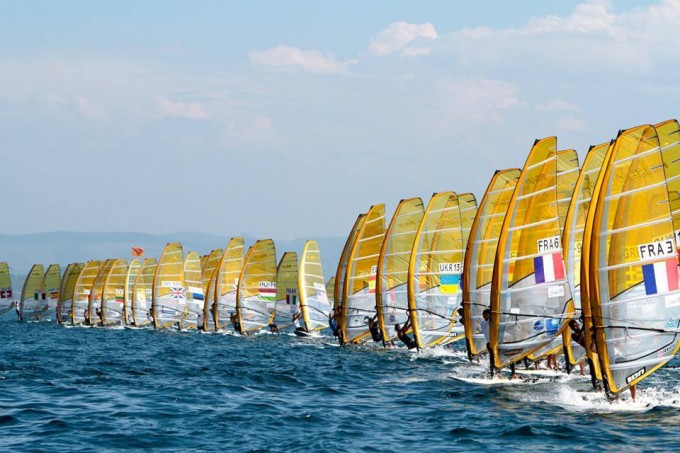
This discipline is in itself split into many different categories which incorporates almost all wind strengths from RS:X which is used in the Olympics designed specifically for use all over the world at different venues, inland and costal. Formula which has kit that can get planning in about eight knots of wind and Slalom which can be done in some of the highest wind speeds nature can put out.
All of the aforesaid disciplines do at some stage interlink and defining them can sometimes be difficult. I have used wind strengths for a typical windsurfer but that is not to say that for all of the above there will be many exceptions. Lighter/more skilled sailors will be able to get going earlier, slightly different conditions will allow different opportunities and as kit progresses people are able to get out more and more. So a forecast to a windsurfer is like opening a book with the same content, yet arriving at an infinite amount of different endings. Depending where you are on your windsurfing journey be sure to check the forecast so you can arrive at your own conclusions as you can be sure the person next to you at your local spot will have arrived at a slightly different one!”
As you progress with windsurfing and sway towards one or other of these disciplines, following the forecast becomes a little more exciting. While it maybe easy to get out on some flat water to go freeriding, you may crave a perfect wave to improve your wave riding or some ultra flat water to learn the new freestyle move.
For many following the forecast and searching for their own personal ideal condition becomes an addiction, James Cox an avid competitor well known for his meteorological knowledge explains why and what many look for in a forecast.
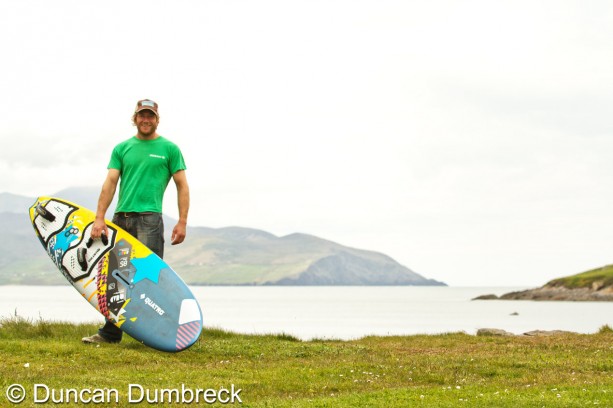
James Cox
“Windsurfers do not have the luxury of booking a court or scheduling a regular after work slot of leisure activity; we wait for the weather to decide when the games can begin. And as a keen windsurfer I know, and thoroughly enjoy, the process of being finely tuned in to the weather forecasts in anticipation of the next brewing storm and the next chance to hit the water. We wait for the latest forecast updates to plan our week ahead. Most often work and social engagements are planned around the windsurfing and the weather.
A chase makes life more exciting and following the weather is exactly that. As a windsurfer you will have your own ideal conditions that you will be looking for – your own idea of perfection! For Steve, George and Amy this will most likely be something such as raw big surf and strong winds; whereas for another individual it might be moderate winds on a secluded and sheltered lake. So we will all be concentrating on the weather forecast, but we might be hoping for different things.
This is just one of the reasons why windsurfing is such an incredible sport. The weather constantly changes the playing field making every session unique. There is no good or bad weather in windsurfing – only good weather! But as suggested above, it’s the extreme weather conditions that keep the most experienced windsurfers perpetually hooked.
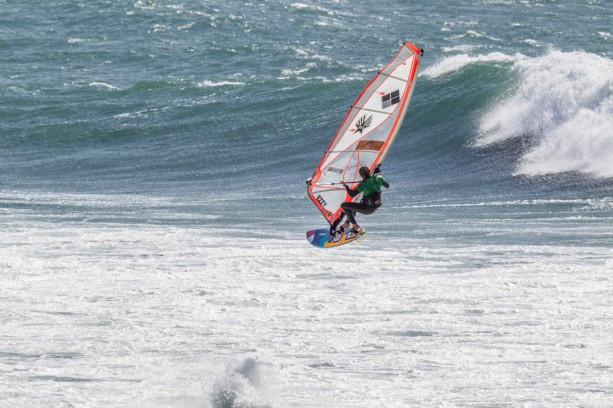
Finding the right weather for your ability is only a part of what we look for (and something that the Met Office website www.metoffice.gov.uk does very well), it is also very important to know which locations handle those conditions the best and which are most suited to you ability level. This is something that Bigsalty Weather www.bigsalty.co.uk focuses on. So in unison these websites allow you to track the weather and locate your ideal location based on the conditions.
The most important weather indicator that you want to look for when windsurfing is of course wind speed and direction. A learner might look for a wind speed of 7-18kts (F3 Bft – F5Bft). This is windy enough to get a response from the sail but not too windy to be out of control. Wind direction or more specifically wind orientation is something else we look for.
As you gain experience of a local area, you may find that a particular wind direction suits one location over an alternative. Indeed you may also find that a specific wind direction may accentuate the wind speed due to a thermal enhancement (e.g. sea breeze) or acceleration due to topography. Beach orientation and sea bed topography also effect what wave action will be present at the beach. This is where the above weather forecasting sites above can help, but it’s also extremely beneficial to pay attention to these localised effects yourself.
Generally speaking, if you are getting in to windsurfing for the first time you don’t have to worry too much about too many detailed weather factors (I am assuming you are taking advice from an instructor) but by making an effort to understand them you can make more sense out of the forecasts available to you and perhaps read between the lines.
As well as wind speed and direction, I personally look at tides and the wave (also known as swell) characteristics: wave height, wave period and wave direction. Broadly speaking, wave height tells me how high the waves may be, wave period tells me how much energy and power the waves will have and the wave direction tells me what angle the waves will need to wrap through to reach my favourite beach. Tides will also affect the waves on their approach to the shore but this effect varies greatly from beach to beach.
Understanding the weather is part of the rich and exciting experience of being a windsurfer. You will never completely master either of these things, but this means there is always something new to keep you hooked.
Essential weather and information websites to take with you on this journey are:
- The Met Office (www.metoffice.gov.uk )
- Bigsalty Weather (www.bigsalty.co.uk)
Additional weather sites that are frequently used are:
- Windguru (www.windguru.cz)
- Magicseaweed (www.magicseaweed.com)”
Steve Thorp
Steve Thorp is one of the few windsurfers that takes his weather addiction even further. Steve can be seen driving inordinate distances, back and forth across the country, around his day job just to find the location with the perfect combination of conditions. He has many tales to tell of when the windsurfing weather has gone his way, and when it hasn’t, here he shares just a few.
“I check the weather websites at least twice a day, to make sure I don’t miss any opportunities for speedsailing or wavesailing. For speedsailing we use a GPS device and compete against windsurfers from around the world by posting our results on gpsspeedsurfing.com. The aim is to just go as fast as possible, to go really fast we need the basic ingredients of flat water and as much wind as possible; with modern windsurfing equipment we can easily sail in a force 10 and this is when we go quickest. Obviously as a speedsailor it’s important not to miss these days as they don’t come around too often!
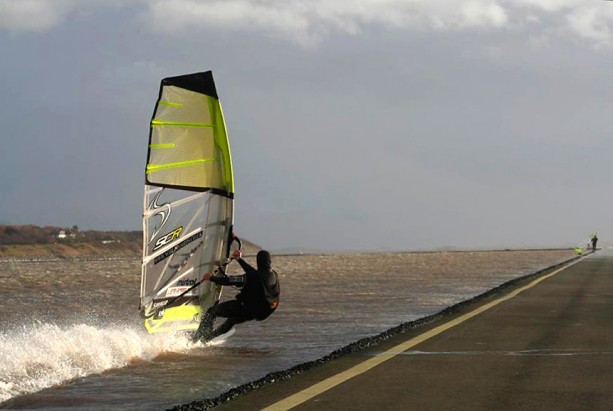
One such day was the 3rd of January 2014. Sailors from all over Europe had been watching the forecast for a week in the build up to the big day. (http://www.gps-speedsurfing.com/default.aspx?mnu=forum&forum=1&val=35343)
West Kirby on the Wirral was predicted winds of Force 9, gusting to Force 10 from a Westerly direction. Perfect. ‘The Kirb’ as it’s known is one of Europe’s best speedsailing venues – a man made lake formed by a wall out into the Dee estuary which gets filled to the brim at high tide and remains full when the tide recedes giving mirror flat water. Westerly winds get a squeeze across the top of Wales, then blow over miles of flat estuary sands before hitting the Kirb with full force.
The day didn’t disappoint, three windsurfers from Holland (Jaques van der Hout, Jurjen van der Noord and Hans Kreisel) set the fastest average speeds putting them firmly into the ‘all time’ GPS top 10 – they’re still leading the 2012 GPS ranking at this point in the year. I set the fastest ever GPS peak speed for a windsurfer at 58mph. January 3rd 2012 was definitely a day to remember and cemented the UK on the world speedsailing map!
It doesn’t always work out though! We once went across the Channel and drove for 10hrs down through France to score a Force 10 Tramontana wind at La Franqui. We were frothing with excitement as we neared the beach, as we could feel the wind buffeting the van, and in contrast to the usual UK speedsailing weather it was brilliant sunshine. Unfortunately, on closer inspection we found that the usually ruler straight sandy beach dropping away into deep water was now a mess of sandbars. We hadn’t known, but three weeks earlier a storm had ‘destroyed’ the beach and our speed strip, with big onshore wind and waves. Two hours later we were driving home.
My other obsession is wavesailing. This is perhaps harder to forecast, as our favourite conditions are perfect, big surf and wind in excess of 20mph which ideally needs to blow at a 30 degree offshore angle to the waves. This is referred to as ‘cross off’ and allows us to ride the waves ‘down the line’ as a surfer would and also holds the waves up giving maximum power when they break, sometimes with enough force to barrel. Those are the dream conditions we long for.
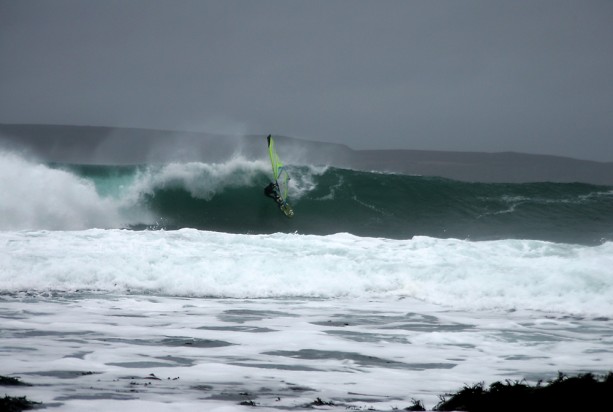
The British Isles are a great place to live as a wavesailor, provided you’re prepared to travel and chase the ideal conditions; the West coast of Ireland, the North coast of Scotland, Devon, Cornwall and many other stretches of the British coastline are all capable of producing world class conditions on their day.
It’s hard to resist a good forecast when you see it and almost always ends up with us driving to the beach, even if it’s 10 hours away on the North Coast of Scotland. I recently made the trip up to Thurso with British wavesailing champion Ben Proffitt on a forecast we couldn’t ignore – strong Westerly winds and waves over 20ft. We knew the waves would wrap around the points up there giving us perfect down the line riding conditions with mast high waves. Another professional windsurfer, Timo Mullen, also turned up having driven from Bournemouth! We all enjoyed some epic conditions which would compare with anywhere in the world, all be it a bit colder than Hawaii or Australia! I’m still feeling the stoke from riding those waves months later….”
There is no doubt, that any windsurfer, at any level will become to rely on the weather and cherish the days on which mother nature delivers. We are at her mercy, but there is nothing like being out in the elements and harnessing the power of the wind as you glide across the water.
Taking your first steps in windsurfing couldn’t be easier, head to Boards Basics to find out more about getting involved.
Edited by Amy Carter – Editor for Boards Magazine www.boards.co.uk and Boardseeker International www.boardseeker.com in conjunction with the MET office .
Check out the MET office guide to Windsurfing and the Weather here and follow the MET office on twitter here.
George Shillito is sponsored by: Tushingham/Starboard, Gul International, O’Shea Surf, Polkerris Beach Company and Liive Sunglasses.
James Cox is sponsored by: Quatro International, Ezzy Sails, K4 Fins, Bigsalty Weather and Bigsalty.co.uk
Steve Thorp is sponsored by: Dave noble windsurfing, Simmer, K4fins and Gps-speed.co.uk

